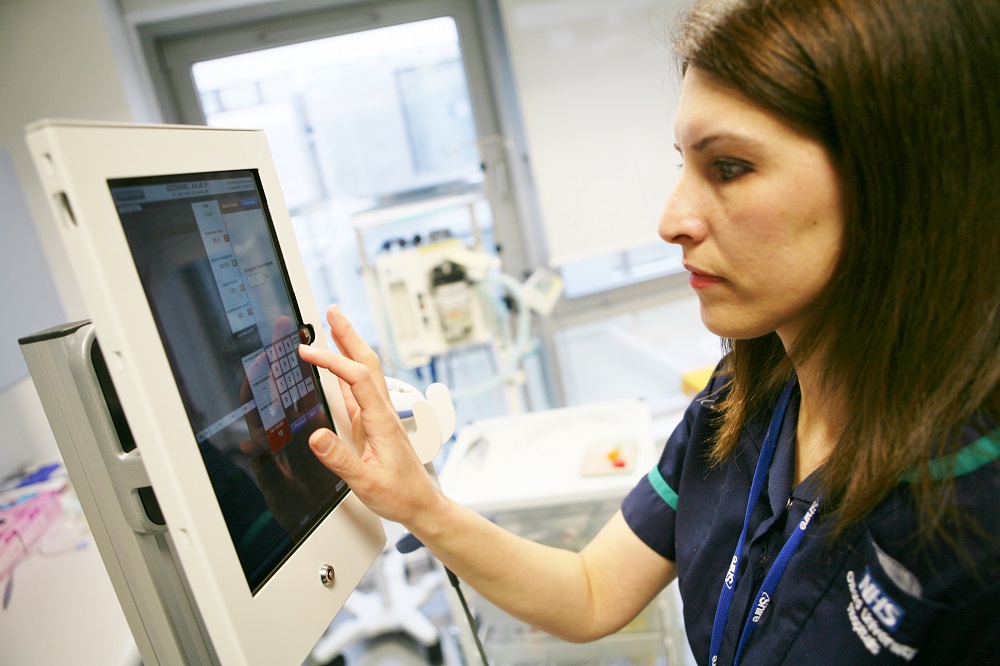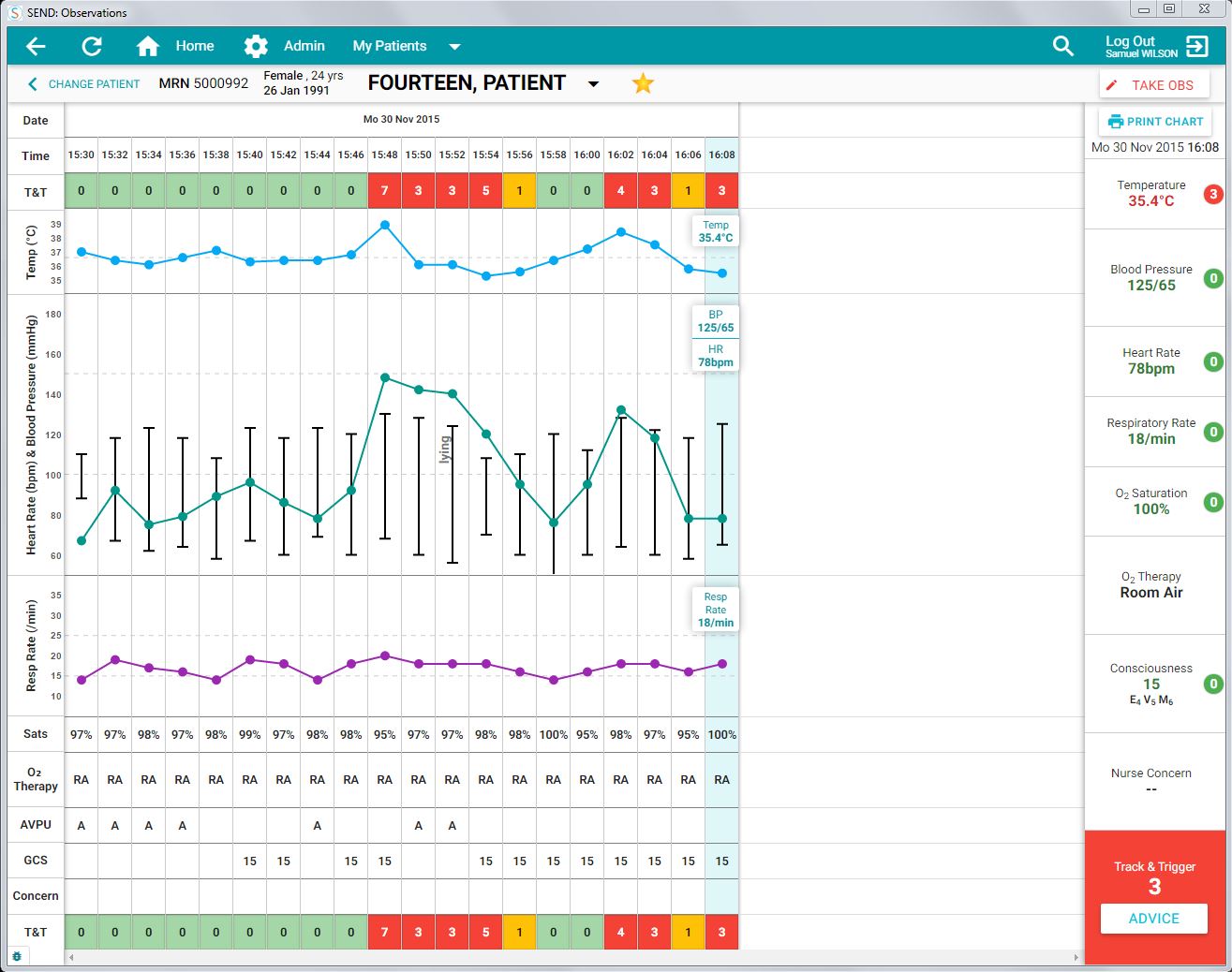
A project to replace bedside paper charts with “early warning” tablet computers to identify at risk patients at Oxfordshire acute hospitals is now being rolled out at Oxford’s John Radcliffe Hospital.
Oxford University Hospitals NHS Foundation Trust this week started to bring its System for Electronic Notification and Documentation (SEND) project to the Headington hospital.
It is the final Trust hospital to receive the system after it was introduced at Oxford’s Churchill Hospital and Nuffield Orthopaedic Centre and Banbury’s Horton General Hospital.
The technology has been devised and researched through the NIHR Oxford Biomedical Research Centre, a collaboration between the Trust and the University of Oxford. The University’s Institute of Biomedical Engineering created the software for SEND.
It works through staff inputting a patient’s vital signs such as heart rate and blood pressure into a tablet computer by patients’ beds.
The tablet – which links to patient barcode wristbands to identify them – immediately provides advice on how to manage the patient’s care and clearly displays any deterioration in their condition.
It also means information about patients can be shared around the Trust, including on desktop computers, saving crucial time that was previously spent looking for and transporting paper charts.
The system aims to improve patient care and safety by making their clinical condition available to the right people at the right time.
This is aimed at reducing problems such as prolonged hospital stays and poor long-term health outcomes.
Funding to put the system onto wards has been provided by the Department of Health’s Safer Hospitals, Safer Wards NHS Technology Fund.
The previous “track and trigger” system involved staff documenting vital signs on paper charts and manually working out the state of the patient’s condition.
The SEND system means staff including doctors and nurses can log-in to view any patient’s notes from any of the tablets or desktop computers.
This means a clinician at the Churchill Hospital, for example, could see information about a John Radcliffe Hospital patient, saving time and ensuring quicker decision making.
The observations are also stored in the patient’s electronic medical records, called the Electronic Patient Record (EPR).
Since its launch in 2014 more than two million vital signs have been recorded through SEND for more than 12,000 patients by more than 4,000 staff members.
These vital signs have been recorded using more than 140 tablet computers. More than 300 will be in use when the project is completely rolled out at the John Radcliffe, estimated to be May next year.
Each ward has about six tablet computers. The system has been rolled out in general medical wards on level seven of the John Radcliffe this week.
The full observations collected are heart rate, blood pressure, respiratory rate, oxygen saturations, temperature and conscious level. Nurses can also record further concerns about their patients such as vomiting or a colour change in their complexion.
The project will also aid research announced this year into how data about patients can be combined to identify those who are in hospital who are at risk of being transferred to intensive care.
The HAVEN project will use data from SEND along with other data such as blood test results and previous medical history to develop a new electronic system to help intensive care specialists spot critically ill patients earlier.
The Research Council UK’s Digital Economy Programme, which is led by the Engineering and Physical Sciences Research Council (EPSRC), funded the team’s research underpinning the SEND system.
Professor Lionel Tarassenko, the Head of the Department of Engineering Science, who also leads the IBME group which carried out the original research said: “This is a another example of the close collaboration which exists in Oxford between engineering and medicine, taking new concepts all the way from the research lab to the bedside.”
Dr Peter Watkinson, a John Radcliffe Consultant in Intensive Care Medicine, who is leading the programme, said: “We are delighted to be rolling out SEND at the Trust’s largest hospital and look forward to seeing the benefits that staff have had at the Churchill Hospital, Nuffield Orthopaedic Centre and the Horton General Hospital.
“Harnessing the advances in digital technology that have benefited societies the world over has been a key priority for research in Oxford and we look forward to bringing this system to more patients.”
Life Sciences Minister George Freeman MP said: “By investing in digital technology to monitor patients’ vital signs we will see improvements in patient safety and better results for patients.
“This project is an example of the great work the National Institute for Health Research is doing to support trials of new innovations in places such as Oxford so that they can be rolled out across the NHS.”
Tilly Lightfoot, a staff nurse on the 7C acute general medicine ward at the John Radcliffe, said: “It is a lot more effective because it works out your track and trigger score immediately so you can see straight away what it is rather than having to work it out. It is a lot quicker and easier and means you have more time to spend doing other things.”
Dr Louise Channon, a junior doctor in acute general medicine at the hospital, who was introduced to the system this week, said: “At first use SEND seems very straightforward and easy to work with.
“It is good that you can look at observation trends from a distance in a clear format which means you can keep a closer eye on your patients if you are physically unable to be on the ward at that specific moment in time.”
